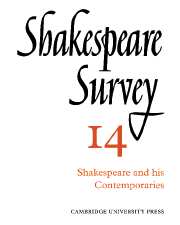Book contents
- Frontmatter
- Studies in Elizabethan and Jacobean Drama since 1900
- Shakespeare and Lyly
- Shakespeare and Mundy
- Marlowe as Provocative Agent in Shakespeare’s Early Plays
- The Tragedy of Revenge in Shakespeare and Webster
- The Simplicity of Thomas Heywood
- The Tragic Vision of Fulke Greville
- Shakespeare v. The Rest: The Old Controversy
- Shakespeare’s Gentleness
- Milton on Shakespeare
- An Unrecorded Elizabethan Performance of Titus Andronicus
- Stratford-upon-Avon a Hundred Years Ago
- International Notes
- Shakespeare Productions in the United Kingdom: 1959
- Three Directors: a Review of Recent Productions
- The Year's Contributions to Shakespearian Study 1 Critical Studies
- 2 Shakespeare’s Life, Times and Stage
- 3 Textual Studies
- Books Received
- Index
- Plate section
2 - Shakespeare’s Life, Times and Stage
Published online by Cambridge University Press: 28 March 2007
- Frontmatter
- Studies in Elizabethan and Jacobean Drama since 1900
- Shakespeare and Lyly
- Shakespeare and Mundy
- Marlowe as Provocative Agent in Shakespeare’s Early Plays
- The Tragedy of Revenge in Shakespeare and Webster
- The Simplicity of Thomas Heywood
- The Tragic Vision of Fulke Greville
- Shakespeare v. The Rest: The Old Controversy
- Shakespeare’s Gentleness
- Milton on Shakespeare
- An Unrecorded Elizabethan Performance of Titus Andronicus
- Stratford-upon-Avon a Hundred Years Ago
- International Notes
- Shakespeare Productions in the United Kingdom: 1959
- Three Directors: a Review of Recent Productions
- The Year's Contributions to Shakespearian Study 1 Critical Studies
- 2 Shakespeare’s Life, Times and Stage
- 3 Textual Studies
- Books Received
- Index
- Plate section
Summary
Leslie Hotson’s latest work persuasively—and in his usual provocative manner—condenses a mass of new scholarship; at the same time (though this is not his intention) it crystallizes much of our disquiet at the overwhelming preoccupation today with the ‘open’, ‘platform’, or ‘arena’ stage. After an unhappily ‘tuppence coloured’ opening (‘Scandal Packs the Globe’) we are given a cumulative argument on Shakespeare’s ‘theatre in the round’ which turns upon the analysis of the earlier pageant theatre, the textual and pictorial evidence for the form of the Elizabethan theatre, and the analogies with the stage methods of private performances at court and in university halls and chapels. This suggests familiar ground but it is reinterpreted in revolutionary manner. The ‘De Witt’ drawing is read to demonstrate that the important ‘Lords’ room’ (with the ‘stage sitters’ beneath) is located ‘at the back of’ the platform, producing a performance totally in the round; the ‘tiring-house’ is beneath the stage, to which there is access through traps; particular locations, ‘discoveries’, ‘throne of state’, ‘righteous heaven and sinister hell’, all are to be found in the permanent skeletal structures on either side of the platform, which may be of two shallow stories and curtained or uncurtained at need—an arrangement strikingly anticipated by Giotto in his Santa Croce fresco, ‘The Ascension of St John’ (Plate 114 in Berenson’s The Italian Painters of the Renaissance, Phaidon Press, 19521952). But though this latter device had a venerable and continuous history in painting, and resembles the impermanent booths assumed by G. F. Reynolds, permanent structures would appear to inconvenience a greater number of spectators than Hotson admits.
- Type
- Chapter
- Information
- Shakespeare Survey , pp. 149 - 156Publisher: Cambridge University PressPrint publication year: 1961



